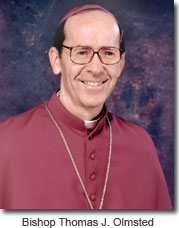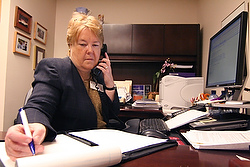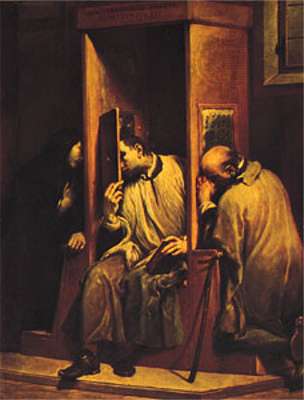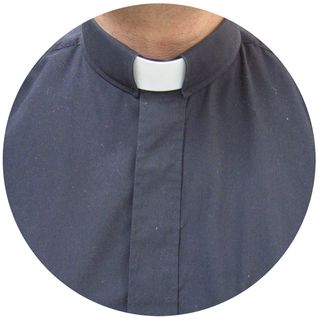 This will be a long one, so let me summarize the key points right up front:
This will be a long one, so let me summarize the key points right up front:
* One of the documents contained in the New York Times files on the Fr. Lawrence Murphy case is a memo in Italian summarizing a meeting that was held at the Congregation for the Doctrine of the Faith about Fr. Murphy.
* This memo has not had a professional English translation until now.
* The new translation is a smoking gun in that it reveals how badly the New York Times and others have botched the story.
* Then-Cardinal Ratzinger was not present at the meeting. It was run by the Secretary of the CDF, then-Archbishop Bertone.
* Cardinal Ratzinger’s name never comes up, making it impossible to determine anything regarding his involvement in this case.
* In the meeting Bertone points out the difficulties in proceeding with canonical trial for Fr. Murphy, but he does not forbid one.
* The chief difficulty, according to Bertone, is gathering the needed proof against Murphy given the passage of time (not Murphy’s advanced age or ill-health, neither of which is mentioned at all).
* Bertone is appalled at how long this case has been allowed to linger and by the fact that Murphy apparently still has the ability to celebrate Mass for the deaf community in Milwaukee. He insists that this be rectified.
* He also insists that Fr. Murphy be made to reflect on the gravity of his crimes and to furnish proof of his repentance.
* If he fails to do so, Murphy can have additional penalties inflicted on him, including “dismissal from the clerical state” (i.e., laicization, “defrocking”).
* The CDF is thus not opposed to defrocking Murphy.
* A note on the same meeting by Bishop Sklba states that Bertone also said that a new canonical process can be initiated against Murphy if he violates directives not to have contact with the Milwaukee deaf community.
* In audio interview referencing the same meeting Archbishop Weakland also characterizes the CDF’s response as a “suggestion,” says that he doesn’t think Cardinal Ratzinger was personally involved with these types of cases at this point, says that everyone—including Weakland himself—moved slowly, and says that trying to initiate a canonical case to defrock a priest was something unusual at the time.
One can still criticize the way the CDF handled the case, but the memo does not reveal a portrait of Bertone—much less Ratzinger—as unwilling to take action against Fr. Murphy. A current trial is not prohibited, and even if one is not held, Murphy is not off the hook. He must be prohibited from contact with the community he has harmed, if he fails to provide proof of his repentance he is at risk of being defrocked, and if he breaks the new rules a further canonical process against him could begin.
Now the long form . . .
The other day while composing the first post regarding Cardinal Ratzinger’s (non-)involvement in the Lawrence Murphy paedophilia case I was frustrated by the fact that one of the key documents was available only in Italian and with a really, really lame machine translation done back in 1998.
The document was a memo summarizing a meeting on May 30, 1998 at the Congregation for the Doctrine of the Faith between Archbishop Bertone, the secretary of the CDF and thus the man responsible for its day-to-day operations, and the American bishops involved in the Murphy case.
I figured I’d do the best with it I could, but there were likely additional facts in the document that would emerge in future discussion, once the matter was out on the blogosphere.
Boy, was that right!
This is the smoking gun memo for the case. It reveals just how completely wrong the New York Times and the mainstream media have gotten this story.
I owe a Ten Gallon Cowboy Hat Tip to translator Lori Pieper (BIO) (BLOG) for THIS PROFESSIONALLY DONE TRANSLATION. (HER COMMENTARY.)
Just as the New York Times and other media outlets never contacted key figure Fr. Thomas Brundage before running the story, it appears that they also never got a professional translation of the document, with the result that important facts were left out entirely—or ended up being misrepresented in the press to convey the opposite impression.
So much for the MSM’s “layers of fact checkers.” They couldn’t even have their correspondent in Italy (I assume that person can translate Italian to English?) do a translation of an obviously key document (a meeting held at the Vatican regarding the very case they’re investigating? Sheesh!).
But thanks to the blogosphere and its Army of Davids, we now have a translation. (All emphases, both bold and italics, in the original.)
So what does it say?
Summary of a meeting between the Superiors of the CDF and Their Excellencies the Prelates involved in the case of Lawrence C. Murphy, a priest accused of solicitation in Confession (Prot. No. 111/96).
As the title reveals, the reason that the CDF was involved in this case is that it involved a priest accused of sexual solicitation in the confessional—not because it involved paedophilia. At the time, the CDF did not have a mandate to cover paedophilia (those were normally handled by the local bishop or, if appealed to Rome, by a different Vatican court—the Roman Rota). But the CDF did (and does) have a mandate to deal with cases involving priests who commit sexual solicitation in the confessional.
The meeting took place on Saturday, May 30, 1998 in the office of the CDF. Present for the CDF were: His Excellency, Archbishop Tarcisio Bertone, Secretary, who presided over the meeting, the Rev. Father Gianfranco Girotti, Undersecretary. Don Antonio Manna of the Disciplinary Office, Don Michael Jackels (translator) and Fr. Antonio Ramos. Present were Their Excellencies the prelates who had requested the meeting: His Excellency, Rembert Weakland, Archbishop of Milwaukee (USA), his Auxiliary, His Excellency, Richard Sklba and His Excellency, Raphael Fliss, Bishop of Superior (USA).
Note who is not in attendance: Cardinal Ratzinger. It is possible that Bertone was acting on Ratzinger’s instructions in this meeting, but it is also possible that he was acting independently. We just don’t know. Ratzinger’s name never even comes up in this document.
Also note that the CDF has a Disciplinary Office, which is represented at the meeting by Don Antonio Manna. This is not the only case the CDF has to work on.
As the meeting starts, Milwaukee Archbishop Rembert Weakland begins with a summary of the case:
1. His Excellency Archbishop Weakland briefly set forth the previous facts of the case, bringing out the following points: 1°) there have turned out to be many victims of the abuses by Fr. Murphy, all of them deaf; 2°) in 1974, there was an intervention in Fr. Murphy’s case, but nothing had been recorded in the archdiocesan archives (it appears that there was a civil lawsuit, which ended without any penalty being imposed on the accused and the intervention consisted of sending the said priest to another diocese, i.e. Superior); 3°) the deaf community is now experiencing great indignation because of this case and refuses any pastoral solution; 4°) because of the long period of time that has passed since the events took place, it is no longer possible to begin a civil lawsuit in the state of Wisconsin; 5°) Fr. Murphy has no sense of remorse and does not seem to realize the gravity of what he has done. In addition, 6°) there is the danger of great scandal if the case is publicized by the press. According to the testimonies that have been collected, Fr. Murphy’s misdeeds had their origins in Confession.
Point 2 is startling, shocking even. For there not to be diocesan records concerning the 1974 “intervention” (that is, the action undertaken by the diocese) under Weakland’s predecessor Archbishop William Cousins reveals an instance of appalling incompetence at best.
Point 3 is the primary motivator for Weakland taking canonical action against Murphy. The deaf community will not find other solutions acceptable at this point.
Actually, there is more to it than this. Though the memo speaks of the deaf community as a united whole, in a recent audio interview with the BBC Weakland states that there was a sharp division in the Milwaukee deaf community over this case, with the younger members—who had been abused—indignant and the older members—who saw Murphy as someone helping them—taking his side.
It might be more accurate, then, to say that certain elements of the local deaf community would not accept anything other than a trial at this point.
Point 4 is another reason for canonical action. Because the Wisconsin statute of limitations has expired, the deaf community cannot begin an action against Murphy in civil court. If there is to be a judicial action taken against him, it must be in Church court.
Note that the idea of keeping the case secret is not on the table. The matter is public, and the civil authorities already knew (see point 2, above). It appears that if a civil lawsuit were still possible, nobody in the room would object to it.
Point 5 is the assessment that Fr. Thomas Brundage (see link above) and others involved in the case came to, though Murphy claimed the contrary in his January 1998 letter, in which he said that he had repented of his past transgressions. Nevertheless, as we will see, it is the assumption that he is not properly repentant that the meeting will proceed on.
Point 6 reflects the natural desire to avoid scandal. But be careful here. In ecclesiastical-speak, “scandal” does not just mean controversy. It means “to cause (others) to stumble” in their faith or morals (Greek, skandalizein, “to cause to stumble,” “to trip”), such as alienating people from Christ and his Church through the actions of sinful ministers—something any bishop would and should want to avoid.
Note that Weakland wants to pursue canonical action against Murphy to provide justice for abused members of the deaf community and heal the rift Fr. Murphy has created. And at the same time he wants to avoid the scandal and alienation that sensationalistic press coverage would generate.
It is one thing to try to avoid taking action in order to minimize press coverage. It is another to want to take action while minimizing scandal. It’s hard to fault Weakland for wanting to take the latter path.
One note on Weakland’s last point: The memo states that Fr. Murphy’s crimes “had their origin in Confession.” In the audio interview, Weakland clarifies that he’s not saying that they physically took place in the confessional but that they were in some way connected to the confessional. (Perhaps, e.g., he used his knowledge from the confessional to identify potential abuse victims.) This may relate directly to one of the difficulties that Archbishop Bertone points out.
Now that Weakland has had his say, Bertone of the CDF has his:
2. His Excellency the Secretary of the CDF—stressing both the long period of time that has now passed (more than 35 years!) from when the events took place, which constitutes the true problem even on the canonical side, and the fact that there has been no report of other crimes perpetrated or scandals created by Murphy during these years in Superior—maintains that there is insufficient information to instruct a canonical process. Nevertheless, he stresses, it is unacceptable for him [Murphy] to be able to go and celebrate the Eucharist in the deaf community in Milwaukee; it will be necessary, therefore, to impede him, having recourse also to some penal remedies. For precautionary reasons, he can be ordered to celebrate the Eucharist only in the diocese of Superior, especially since this is agreed to both by his Ordinary, i.e. the Archbishop of Milwaukee, and the Ordinary of the place where he resides. But such a provision must be communicated to him in writing. [1]
Note the element of exasperation at how long this has been allowed to linger (that exclamation point after “35 years” is there in the Italian). Because of this, Bertone feels that there is not enough information to properly inform a canonical process against Murphy. As a secondary point, he notes that there have been no new allegations against Murphy, but even though the statute of limitations has already been waived in terms of Church law, the gobsmacking lack of documentation and amount of time that this case has been left to linger creates significant hurdles for prosecuting this case.
That does not mean inaction at this point. On the contrary, Bertone now turns to measures that should be taken against Murphy even in the absence of an ecclesiastical trial.
He is indignant that Murphy has the ability to celebrate Mass for the deaf community in Milwaukee.
There is some confusion about precisely what Murphy did and was allowed to do in this matter. One source, from Feb 1997, suggests that Weakland and Sklba of Milwaukee have directed Murphy not to have contact with deaf people but that there is “some indication from the diocese of Superior” that he has done so by saying Mass and helping with retreats for the deaf.
Murphy’s own letter, from January 1998, indicates that his ministry was never restricted by Weakland’s predecessor, Cousins, and that thus he has on occasion said Mass at parishes in the diocese of Superior and helped at retreats for the deaf. He also states that he has complied with every directive of Cousins and now Weakland.
From the documentation I’ve been able to review, it is not clear just what the facts are. It may be there, but I haven’t seen proof that Murphy was saying Mass for the deaf in the Milwaukee archdiocese (or for the deaf in the diocese of Superior). It strikes me as unlikely that Murphy would say he had complied with all of Weakland’s directives if he knew that Weakland could produce a document showing him to be in violation. So perhaps Weakland only communicated the directive orally. Or perhaps there was miscommunication. Or perhaps the source quoted in the Feb. 1997 document was under the mistaken impression that such directives had been communicated when they hadn’t been.
In any event, Bertone is acting on the premise that Murphy still legally has the ability to celebrate the Mass for the deaf community in Milwaukee, and he is indignant and determined to end that.
The language he uses—for anyone familiar with the ultra-polite, ultra-diplomatic way that Catholic bishops speak to and about each other—is dramatic.
First, he says that is is “unacceptable” that Murphy has the ability to go and say Mass for the Milwaukee deaf community. In the language of bishops, saying this is “unacceptable” translates into normal speech as, “Why haven’t you taken care of this already, you fools? How can you possibly allow this criminal to continue to have contact with the very community he has harmed? You don’t need a trial to stop him from doing that. Use your authority as bishops!”
Thus he says it will be “necessary” (charged term) to “impede” (charged term) Murphy, including having recourse to the infliction of “penal remedies” (charged term).
BTW, Bertone may have been even more blunt about all this in person. What we are dealing with is the exquisitely politely-drafted memo version.
“For precautionary reasons” (i.e., to protect the Milwaukee deaf community from further scandalization—or even abuse—by Murphy), the two bishops can take immediate action. Together Weakland (the ordinary or episcopal “boss” to whom Murphy reports) and Fliss (the ordinary or episcopal “boss” of the place where Murphy lives) can order him not to celebrate Mass except in the Diocese of Superior, thus preventing him from doing so for the deaf community in Milwaukee.
This order “must” (charged term) be communicated to him in writing so that there can be no mistake about it. No “he said; he said.” (Perhaps this is an indication that prior directives to Murphy—if any—had been oral in nature.)
You don’t need a trial for this, guys. Do it!
Don’t let yourselves be hung up by a trial, because there are some hurdles there . . .
3. In regard to the possibility of a canonical process for the crime of solicitation in Confession, His Excellency the Secretary draws attention to some problems that it presents: 1°) first of all the difficulty of proving such a crime, the interpretation of which will have to be made in stricto sensu [in the strict sense]; 2°) the difficulty that deaf people have in furnishing proof and testimonies without aggravating matters, keeping in mind both the limits inherent in their disability and the distance of the events in time. Nevertheless, he stresses, it will be necessary to make Murphy reflect seriously on the grave nature of the evil he has done and on the fact that he will have to give proofs of reformation. 3°) He mentions finally the broad right of [self]-defense that exists in the U.S. and the difficulties that would be put forward by the lawyers in this direction.
Point 1 is Bertone’s real concern here: “the difficulty of proving such a crime.” Notice that, despite the fact that Murphy had sent a letter pleading ill-health as a reason not to proceed. Bertone’s concern is with the difficulty of using a trial under these circumstances, not with Murphy’s health. The latter may well have been one motivating factor in the CDF’s recommendations, but it doesn’t appear in the minutes of this meeting.
And so Bertone points out several difficulties with the proposition of going to trial.
Here we arrive at a place where the previous, machine translation, is positively misleading. Contrary to Andrew Sullivan and reader Carolyn Disco, who are dependent on the machine translation, Cardinal Bertone does not speak of increasing scandal or the need for secrecy. What Cardinal Bertone refers to is the need to prove that the crime has been committed “in the strict sense” (not proving it “in strict secrecy”) and that this will be difficult without “aggravating matters” (not “increasing the scandal”).
The first difficulty Archbishop Bertone mentions (dealt with in the latter part of point 1) is that the law applied to Murphy will have to be interpreted in the strict sense.
This refers to a point in canon law that may not be obvious. According to canon 18 of the Code of Canon Law,
Can. 18 Laws which establish a penalty, restrict the free exercise of rights, or contain an exception from the law are subject to strict interpretation.
The purpose of this canon (among other things) is to prevent innocent people from having penalties inflicted on them based on loosey-goosey readings of the law. If you’re going to be hit with a penalty, it should be unambiguous that you violated the law. (Note that this applies not just to priests, but to anybody who could be hit with a penalty. It’s related to the “innocent until proven guilty” ethic.)
Thus penal laws applied to Murphy will have to be interpreted in the strict sense. That means that you will have to prove that his actions clearly violated the letter of the law, not debatably violated it, not violating its spirit or intent, but clear violation of the letter of the law itself.
This opens up potential challenges that Murphy’s advocate could make in the case.
For example, remember how in the audio interview Weakland cautioned that the crimes may not have been in the confessional itself but only had some connection with it or “had their origin” in it, the way the memo states? Perhaps Weakland has a weak case against the guy in terms of proving a connection with the confessional. Murphy’s canonical advocate could certainly argue fallibility of memory after this many years.
We know how defense attorneys are (and you have to let the guy have a defense attorney or there is not even a pretense of justice): “Is Victim A really sure that Murphy said this to him in confession and not outside of it? How can he be sure after so many years? How does he know that Murphy’s abuse of him wasn’t based on attraction he felt independently and not based on what was said to him in confession? It’s one thing when these kinds of things are fresh in memory, but after 35 years?”
Remember: If Weakland wants to run this case under the auspices of the CDF then it needs to be tried on what the CDF has competency over at this time, which is abuse of the sacrament of confession. If Weakland wants to run it as a paedophilia case then the normal dicastery to contact would be the Roman Rota, not the CDF.
So Weakland may have made a mistake not only by waiting so long to deal with the case but also by picking a dicastery that doesn’t have the right jurisdiction given the evidence he can provide.
Also related, though not specifically mentioned here, is that like any priest accused of misconduct in the confessional, Murphy is hampered in making his own defense by the fact that he can never (under pain of automatic excommunication) violate the seal of confession. According to the Code of Canon Law,
Can. 983 §1. The sacramental seal is inviolable; therefore it is absolutely forbidden for a confessor to betray in any way a penitent in words or in any manner and for any reason.
“For any reason” includes your own defense in a Church trial. Even to prove your own innocence, you can’t break the seal.
That makes hearing these kinds of cases harder, since one of the parties is significantly impeded from being able to tell his side of the story.
In point 2, Bertone brings out another difficulty in proceeding with the case, namely, “the difficulty that deaf people have in furnishing proof and testimonies without aggravating matters.”
I have to say that I don’t know what Bertone is referring to here. The memo tries to clarify by referencing “the limits inherent in their disability and the distance of the events in time.”
Perhaps Bertone is thinking that, given the utter lack of documentation from the 1970s, that it would aggravate matters for the deaf community by forcing members of it to undergo deposition via an interpreter in ways that could rip open old wounds about painful experiences a long time ago.
This could be particularly true if, as Weakland says in the audio interview, the local deaf community was divided, with one generation taking Murphy’s side and another opposing him.
Or perhaps he thinks that deaf people somehow have difficulty communicating matters with precision due to the nature of sign language (in which case he doesn’t—or at least didn’t—have much awareness of how American Sign Language works; it can be just as precise as spoken languages). Or perhaps he is thinking that some deaf people have difficulty communicating because their parents do not arrange for their children to have a good education in sign language and proper exposure to the deaf community (though that would not seem to be the case in a school for the deaf).
He does seem to be thinking of the fact that, for both the hearing and the deaf, our memories aren’t always as reliable as we would want concerning long-ago events, including—and perhaps especially—traumatic events.
Whatever the case here—and it may simply be bad memo drafting since we don’t have Bertone’s own words—he thinks that it will be difficult to get the needed proof for a trial.
Despite this, and in the same point, Bertone stresses that it will be “necessary” (charged word) “to make Murphy reflect seriously on the grave nature of the evil he has done and on the fact that he will have to give proofs of reformation.”
So Murphy is not to be let off the hook if a trial doesn’t proceed. He’s going to have to reflect on the gravity of his sins and provide proof that he has repented.
In point 3 Bertone cites a third difficulty for a trial, which is “the broad right of [self]-defense that exists in the U.S. and the difficulties that would be put forward by the lawyers” acting on Murphy’s behalf.
The memo doesn’t say, but it is possible Bertone is thinking not just of Murphy’s canonical advocate in the Church trial but of civil lawyers getting involved and trying to interfere with ecclesiastical proceedings. Indeed, that may be what he is thinking since under the Church’s internal law, priests in America don’t have any broader right of self-defense than priests in other countries (though American priests might seek to exercise their canonical rights more aggressively).
So, while he doesn’t exclude the possibility of a trial of Murphy, Bertone notes various difficulties that one would face, while simultaneously insisting that actions must be taken against Murphy.
Weakland then agrees to such actions . . .
4. His Excellency Archbishop Weakland commits himself to try to obtain from Father Murphy—whom he compares to a “difficult” child—a declaration of repentance; all three psychologists who have examined him consider him a “typical” pedophile, who therefore “considers himself a victim.” In this regard, the Under-Secretary [of the CDF] Father Gianfranco Girotti, stresses that the said priest will have to give clear signs of repentance, “otherwise we will have to have recourse to a trial.” His Excellency the Secretary [i.e. Bertone] proposes imposing on him a period of spiritual retreat together with a salutary admonition in order to be able to understand whether he really is repentant or not, otherwise, he would expose himself to the risk of having more rigorous measures imposed on him, not excluding dismissal from the clerical state. He then advises entrusting him to a priest as his spiritual director, with meetings every one or two months.
Here we have arrived at another point where the original machine translation is badly misleading. It is incredibly garbled. Among other things, it makes it appear that three psychologists would need (in the future) to evaluate him and determine if he is a typical paedophile. In fact, as the above translation makes clear, three psychologists have examined him and found him to be a typical paedophile.
Worse, the machine translation leaves out altogether Bertone’s proposal of “imposing on him a period of spiritual retreat together with a salutary admonition in order to be able to understand whether he really is repentant or not, otherwise, he would expose himself to the risk of having more rigorous measures imposed on him, not excluding dismissal from the clerical state” (emphasis in original). Dismissal from the clerical state is laicization or “defrocking,” so defrocking Murphy is explicitly on the table in this meeting. Yet the machine translation leaves it out entirely.
So, far from opposing a trial, on grounds of age or health or anything else, the undersecretary of the CDF indicates that “we will have to have recourse to a trial” if Murphy doesn’t furnish “clear signs of repentance.”
Bertone goes farther, saying that Murphy needs to be sent on retreat with the warning that if he doesn’t come back seriously repentant that he will risk exposing himself to “more rigorous measures [being] imposed on him,” including “dismissal from the clerical state.” He also wants a spiritual director to keep tabs on Murphy.
5. His Excellency the Secretary finally sums up the two central points of the line to be followed in regard to the priest, in a word: 1°) the territorial restriction of the celebration of the Eucharist and 2°) the admonition to induce him to show remorse.
So, whether there is a trial or not, two points are definitely to be followed: Keep Murphy from celebrating Mass for the Milwaukee deaf community and take steps to provoke repentance, with the warnings above about what will happen if he’s not properly repentant, age and anything else notwithstanding.
Weakland then get the last effective word:
Before the conclusion of the meeting, Archbishop Weakland thought it important to restate that it will be difficult to make the deaf community understand the slight extent of these provisions.
And that’s the end of the meeting.
We also have another, briefer account of the meeting in the form of notes that were taken on it by Bishop Richard J. Sklba [RJS in the notes], who was one of the attendees. He writes:
385.
Lawrence Murphy
On May 30, 1998 I joined Archbishop Weakland and Bishop Fliss in meeting with Archbishop Bertone and staff regarding the case. It became clear that the Congregation was not encouraging us to proceed with any formal dismissal on the basis of 24 years of apparent good conduct and the precept impeding exercise of orders currently in effect. We were also cautioned about the difficulty of the question of the Confessional, both in terms of the strict canonical definition of the crime as well as the time lapse between obtaining the information and acting thereon. Archbishop Bertone noted that disobedience of any precept forbidding contact with community members could form the basis for another canonical process.
RJS
So Sklba’s understanding was also that the CDF was “not encouraging us to proceed” but also not forbidding.
An interesting note that wasn’t captured in the official memo summarizing the meeting is Sklba’s last sentence: “Archbishop Bertone noted that disobedience of any precept forbidding contact with community members could form the basis for another canonical process.”
So even if there would be difficulties prosecuting a case this old, if Murphy violates the soon-to-be-imposed requirements not to have contact with the deaf community, he can be nailed for that.
In the audio interview, Weakland also offers a very brief account of the CDF meeting, which he also characterizes as resulting in a “request” to handle the case with restrictions rather than a trial (at the 3:55 mark). Weakland also states (4:40) that he doesn’t think Cardinal Ratzinger was personally involved in this kind of case at this point (i.e., before the CDF was given the mandate to handle them) and that everyone—Weakland himself included—was acting slowly. Weakland states that he probably should have acted ten years earlier (5:10). He also states, very interestingly, that at the time U.S. bishops weren’t really thinking about canonical cases to get priests defrocked (5:15), that what he was trying to do was something unusual for the time—perhaps explaining the difficulty he encountered trying to do it.
 A few months ago, during the height of the latest abuse scandal, the Holy See created a new page on its website offering resources documenting the Church’s response to the problem over the last number of years.
A few months ago, during the height of the latest abuse scandal, the Holy See created a new page on its website offering resources documenting the Church’s response to the problem over the last number of years. A group of 40 or so mistresses of Italian priests, including Stefania Solomone (pictured), want you—and especially Pope Benedict—to know that they don’t like priestly celibacy.
A group of 40 or so mistresses of Italian priests, including Stefania Solomone (pictured), want you—and especially Pope Benedict—to know that they don’t like priestly celibacy. I thought I would take the opportunity to offer a few thoughts on some of the issues raised in the combox of my
I thought I would take the opportunity to offer a few thoughts on some of the issues raised in the combox of my 




